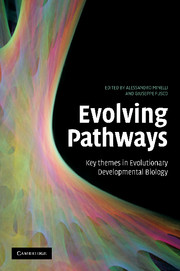Book contents
- Frontmatter
- Contents
- Contributors
- Preface
- Introduction: Pathways of change
- Part I Thinking about evolution by taking development on board
- Part II Evo-devo: methods and materials
- 7 A pragmatic approach for selecting evo-devo model species in amniotes
- 8 On comparisons and causes in evolutionary developmental biology
- 9 Evolution and development: towards a synthesis of macro- and micro-evolution with ecology
- 10 When is a Hox gene not a Hox gene? The importance of gene nomenclature
- 11 Plants are used to having identity crises
- Part III Evolving diversity
- Part IV Evolving body features
- Index
- References
8 - On comparisons and causes in evolutionary developmental biology
Published online by Cambridge University Press: 08 August 2009
- Frontmatter
- Contents
- Contributors
- Preface
- Introduction: Pathways of change
- Part I Thinking about evolution by taking development on board
- Part II Evo-devo: methods and materials
- 7 A pragmatic approach for selecting evo-devo model species in amniotes
- 8 On comparisons and causes in evolutionary developmental biology
- 9 Evolution and development: towards a synthesis of macro- and micro-evolution with ecology
- 10 When is a Hox gene not a Hox gene? The importance of gene nomenclature
- 11 Plants are used to having identity crises
- Part III Evolving diversity
- Part IV Evolving body features
- Index
- References
Summary
Denn mit dem Warum der Dinge kommt niemand zu Ende. Die Ursachen alles Geschehens gleichen den Dünenkulissen am Meere: eine ist immer der anderen vorgelagert, und das Weil, bei dem sich ruhen ließe, liegt im Unendlichen.
[For once you begin with the Why you can never get to the end. It is like the dunes by the sea, where behind each dune lies still another and the Because where you might come to final rest lies somewhere in infinity.]
Thomas Mann, Joseph und seine BrüderComparison is fundamental to any evolutionary developmental analysis (e.g. Alberch 1985, Rieppel 1988, Dohle 1989, Minelli 2003, Scholtz 2005, Deutsch 2006, Jenner 2006, Breidbach and Ghiselin 2007). However, evo-devo as a discipline evolved from a mix of experimental and descriptive approaches to development. Accordingly, different weight is put on the method of studying development in an evolutionary framework depending on a researcher's scientific background. Here I want to evaluate the different approaches and their contribution to addressing evolutionary questions. I stress that only the comparative approach offers a direct method of studying development with respect to evolutionary changes. Descriptive and comparative approaches are often interpreted as being less ‘exact’ than experimental studies because they deal with untestable scenarios. Here I want to show that comparative approaches are a direct means to study evolution if the latter is accepted as the general framework for reasoning about causality and changes and the link between the two.
- Type
- Chapter
- Information
- Evolving PathwaysKey Themes in Evolutionary Developmental Biology, pp. 144 - 159Publisher: Cambridge University PressPrint publication year: 2008
References
- 12
- Cited by



